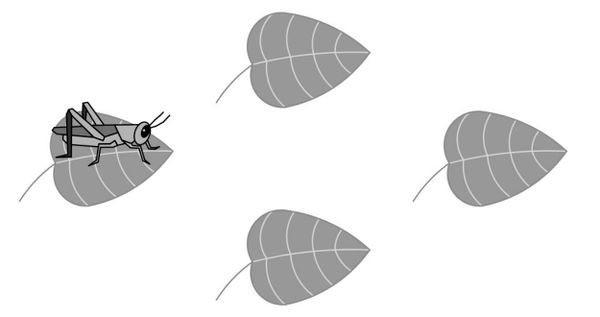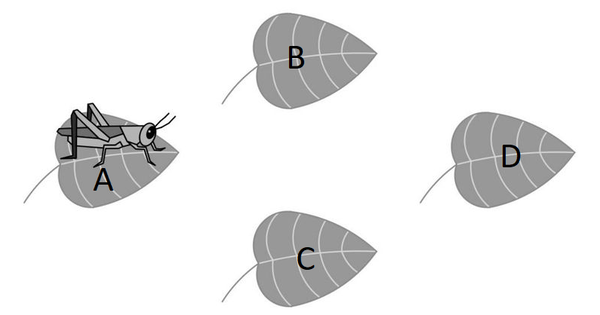Difference between revisions of "2022 AMC 8 Problems/Problem 25"
MRENTHUSIASM (talk | contribs) (→Solution 7 (Simple Enumeration): Reformatted a bit.) |
(→Solution 7 (Simple Enumeration)) |
||
| Line 101: | Line 101: | ||
~sigma | ~sigma | ||
| − | |||
| − | |||
| − | |||
| − | |||
| − | |||
| − | |||
| − | |||
| − | |||
| − | |||
| − | |||
| − | |||
| − | |||
| − | |||
| − | |||
| − | |||
| − | |||
| − | |||
==Remark== | ==Remark== | ||
Revision as of 01:04, 2 March 2023
Contents
[hide]- 1 Problem
- 2 Solution 1 (Casework)
- 3 Solution 2 (Casework)
- 4 Solution 3 (Complement)
- 5 Solution 4 (Recursion)
- 6 Solution 5 (Dynamic Programming)
- 7 Solution 6 (Generating Function)
- 8 Remark
- 9 Video Solution
- 10 Video Solution by OmegaLearn
- 11 Video Solution
- 12 Video Solution
- 13 Video Solution
- 14 Video Solution
- 15 Video Solution
- 16 See Also
Problem
A cricket randomly hops between ![]() leaves, on each turn hopping to one of the other
leaves, on each turn hopping to one of the other ![]() leaves with equal probability. After
leaves with equal probability. After ![]() hops what is the probability that the cricket has returned to the leaf where it started?
hops what is the probability that the cricket has returned to the leaf where it started?
![]()
Solution 1 (Casework)
Let ![]() denote the leaf where the cricket starts and
denote the leaf where the cricket starts and ![]() denote one of the other
denote one of the other ![]() leaves. Note that:
leaves. Note that:
- If the cricket is at
 then the probability that it hops to
then the probability that it hops to  next is
next is 
- If the cricket is at
 then the probability that it hops to
then the probability that it hops to  next is
next is 
- If the cricket is at
 then the probability that it hops to
then the probability that it hops to  next is
next is 
We apply casework to the possible paths of the cricket:

The probability for this case is


The probability for this case is

Together, the probability that the cricket returns to ![]() after
after ![]() hops is
hops is ![]()
~MRENTHUSIASM
Solution 2 (Casework)
We can label the leaves as shown below:
Carefully counting cases, we see that there are ![]() ways for the cricket to return to leaf
ways for the cricket to return to leaf ![]() after four hops if its first hop was to leaf
after four hops if its first hop was to leaf ![]() :
:
By symmetry, we know that there are ![]() ways if the cricket's first hop was to leaf
ways if the cricket's first hop was to leaf ![]() , and there are
, and there are ![]() ways if the cricket's first hop was to leaf
ways if the cricket's first hop was to leaf ![]() . So, there are
. So, there are ![]() ways in total for the cricket to return to leaf
ways in total for the cricket to return to leaf ![]() after four hops.
after four hops.
Since there are ![]() possible ways altogether for the cricket to hop to any other leaf four times, the answer is
possible ways altogether for the cricket to hop to any other leaf four times, the answer is ![]() .
.
~mahaler
Solution 3 (Complement)
There are always three possible leaves to jump to every time the cricket decides to jump, so there is a total number of ![]() routes. Let
routes. Let ![]() denote the leaf cricket starts at, and
denote the leaf cricket starts at, and ![]() be the other leaves. If we want the cricket to move to leaf
be the other leaves. If we want the cricket to move to leaf ![]() for its last jump, the cricket cannot jump to leaf
for its last jump, the cricket cannot jump to leaf ![]() for its third jump. Also, considering that the cricket starts at leaf
for its third jump. Also, considering that the cricket starts at leaf ![]() , he cannot jump to leaf
, he cannot jump to leaf ![]() for its first jump. Note that there are
for its first jump. Note that there are ![]() paths if the cricket moves to leaf
paths if the cricket moves to leaf ![]() for its third jump. Therefore, we can conclude that the total number of possible paths for the cricket to return to leaf
for its third jump. Therefore, we can conclude that the total number of possible paths for the cricket to return to leaf ![]() after four jumps is
after four jumps is ![]() , so the answer is
, so the answer is ![]() .
.
Solution 4 (Recursion)
Denote ![]() to be the probability that the cricket would return back to the first point after
to be the probability that the cricket would return back to the first point after ![]() hops. Then, we get the recursive formula
hops. Then, we get the recursive formula ![]() because if the leaf is not on the target leaf, then there is a
because if the leaf is not on the target leaf, then there is a ![]() probability that it will make it back.
probability that it will make it back.
With this formula and the fact that ![]() (After one hop, the cricket can never be back to the target leaf.), we have
(After one hop, the cricket can never be back to the target leaf.), we have ![]() so our answer is
so our answer is ![]() .
.
~wamofan
Solution 5 (Dynamic Programming)
Let ![]() denote the leaf cricket starts at, and
denote the leaf cricket starts at, and ![]() be the other leaves, similar to Solution 2.
be the other leaves, similar to Solution 2.
Let ![]() be the probability the cricket lands on
be the probability the cricket lands on ![]() after
after ![]() hops,
hops, ![]() be the probability the cricket lands on
be the probability the cricket lands on ![]() after crawling
after crawling ![]() hops, and etc.
hops, and etc.
Note that ![]() and
and ![]() For
For ![]() the probability that the cricket land on each leaf after
the probability that the cricket land on each leaf after ![]() hops is
hops is ![]() the sum of the probability the cricket land on other leaves after
the sum of the probability the cricket land on other leaves after ![]() hops. So, we have
hops. So, we have
![\begin{align*} A(n) &= \frac13 \cdot [B(n-1) + C(n-1) + D(n-1)], \\ B(n) &= \frac13 \cdot [A(n-1) + C(n-1) + D(n-1)], \\ C(n) &= \frac13 \cdot [A(n-1) + B(n-1) + D(n-1)], \\ D(n) &= \frac13 \cdot [A(n-1) + B(n-1) + C(n-1)]. \end{align*}](http://latex.artofproblemsolving.com/a/f/3/af3a2767b442f9e56b57211a4a5929b0170805a2.png) It follows that
It follows that ![]()
We construct the following table:
![\[\begin{array}{c|cccc} & & & & \\ [-2ex] n & A(n) & B(n) & C(n) & D(n) \\ [1ex] \hline & & & & \\ [-1ex] 1 & 0 & \frac13 & \frac13 & \frac13 \\ & & & & \\ 2 & \frac13 & \frac29 & \frac29 & \frac29 \\ & & & & \\ 3 & \frac29 & \frac{7}{27} & \frac{7}{27} & \frac{7}{27} \\ & & & & \\ 4 & \frac{7}{27} & \frac{20}{81} & \frac{20}{81} & \frac{20}{81} \\ [1ex] \end{array}\]](http://latex.artofproblemsolving.com/b/d/1/bd1df096046b87ab283fc76a33865a8de31d019b.png) Therefore, the answer is
Therefore, the answer is ![]() .
.
Solution 6 (Generating Function)
Assign the leaves to ![]() and
and ![]() modulo
modulo ![]() and let
and let ![]() be the starting leaf. We then use generating functions with relation to the change of leaves. For example, from
be the starting leaf. We then use generating functions with relation to the change of leaves. For example, from ![]() to
to ![]() would be a change of
would be a change of ![]() and from
and from ![]() to
to ![]() would be a change of
would be a change of ![]() This generating function is equal to
This generating function is equal to ![]() It is clear that we want the coefficients in the form of
It is clear that we want the coefficients in the form of ![]() where
where ![]() is a positive integer. One application of roots of unity filter gives us a successful case count of
is a positive integer. One application of roots of unity filter gives us a successful case count of ![]()
Therefore, the answer is ![]()
~sigma
Remark
This problem is a reduced version of 1985 AIME Problem 12, changing ![]() steps into
steps into ![]() steps.
steps.
This problem is also similar to 2003 AIME II Problem 13.
Video Solution
Please like and subscribe!
Video Solution by OmegaLearn
https://youtu.be/kE15Sy0B2Pk?t=633
~ pi_is_3.14
Video Solution
https://www.youtube.com/watch?v=85A6av3oqRo
~Mathematical Dexterity
Video Solution
https://youtu.be/Ij9pAy6tQSg?t=2588
~Interstigation
Video Solution
https://www.youtube.com/watch?v=H1zxrkq6DKg
Video Solution
https://youtu.be/0orAAUaLIO0?t=609
~STEMbreezy
Video Solution
~savannahsolver
See Also
| 2022 AMC 8 (Problems • Answer Key • Resources) | ||
| Preceded by Problem 24 |
Followed by Last Problem | |
| 1 • 2 • 3 • 4 • 5 • 6 • 7 • 8 • 9 • 10 • 11 • 12 • 13 • 14 • 15 • 16 • 17 • 18 • 19 • 20 • 21 • 22 • 23 • 24 • 25 | ||
| All AJHSME/AMC 8 Problems and Solutions | ||
The problems on this page are copyrighted by the Mathematical Association of America's American Mathematics Competitions. ![]()











